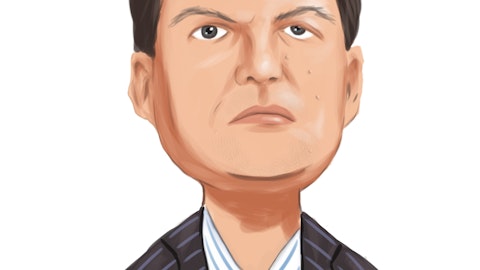Lizzy Doykan : Got it. Thanks. And I wanted to dig into the guide on same-store NOI growth just a bit more. Are we still assuming that range of 3% to 5%? And just given that the spread on snow seems to remain the same or that didn’t change. Just wondering if there’s any changes to your outlook on the assumptions leading to the bottom and the top end of that range?
Michael Haines: No, I would say our internal budget actually had same-center NOI growth starting out slightly down in the first quarter, and then steadily ramping up as we move through the year. So at this point, four months in the year, we’re still on track to achieve same-center NOI growth for the full year. That’s within that guidance range that we put out earlier, including potentially even the higher end of the range. So we’re still comfortable with that range as we stand today.
Lizzy Doykan : Okay. Thanks. And lastly, if I could just get the latest update on your densification efforts. I guess, what’s the latest on entitlement efforts at Crossroads? And then maybe the couple of others you had mentioned last quarter.
Stuart Tanz: Sure. Well, Panola is fully done and fully entitled and we’re just waiting for the right moment in time to put that on the market and sell it. Panola we’re getting very close to getting final entitlements, probably another 60 to 90 days out, maybe a bit longer.
Michael Haines: You said Panola. You meant Novato.
Stuart Tanz: I meant, sorry. Novato, not Panola. And then in Bellevue, in terms of construction on Phase 2 at Crossroads, we’re currently moving through the permitting process, which we now expect to be completed probably by the end of the third quarter. Although it’s difficult to gauge given the pace that the municipality tends to operate at. But once we complete the process at that time, we will determine whether or not to commence construction or wait until there is more clarity in the marketplace.
Lizzy Doykan : Okay. Got it. So just to clarify, I guess, the biggest hindrances are still the same factors as it has been, just — is it due to supply chain or just, I guess, the time line of seeing those delays?
Stuart Tanz: Yeah. I mean it’s really more related to the city of Bellevue and the process internally than it is to supply chain or other things. So — but again, we’re anticipating that. Hopefully, we get through — finally get through this process towards the third quarter, maybe the end. But again, it’s outside of our control.
Lizzy Doykan : Got it. Thank you.
Stuart Tanz: Thank you.
Operator: Thank you. And one moment please for our next question. Our next question will come from Todd Thomas of KeyBanc Capital Markets. Your line is open.
Stuart Tanz: Good morning, Todd.
Todd Thomas : Hi, good morning. I just had a question back on leasing and sort of the rent spreads. The portfolio is 98.3% leased and leasing production was very strong in the quarter. Rent spreads have been solid over the last several quarters, but just curious why leasing spreads are not even stronger just given how little space you have to lease within the portfolio, whether you’re taking a more conservative approach with regard to rents in order to stimulate leasing demand or maybe it’s a mix issue. Can you just talk about that and whether you expect to see pricing power begin to improve a little bit more in the near term?
Richard Schoebel: Sure. I mean, obviously, some of that’s dictated by the specific leases that we’re getting back in terms of where they were at and what the market rents are, but there are a lot of leases that are scheduled to roll that are below and significantly below market, where we’ll see some really good lifts. And then on the renewal side, that is also impacted by options, which are already baked in, and we don’t have any control over those rent spreads. But as you say, with occupancy, it really does give us the leverage and the right opportunities to drive the rents when we have that opportunity.
Todd Thomas : Okay. If we look ahead to the balance of 2023 and also 2024 expirations, what’s the mix like between leases with option rents versus those that you’d be able to renew or negotiate a fair market value?
Richard Schoebel: I don’t have a specific percentage that do not have options, but there are. Some of these properties where the leases have been in place for a while, they are starting to burn off their options. That’s what is driving some anchor tenants to come to us early to secure additional options, particularly in the situation where they want to invest capital in the space. So it’s hard to give you a specific number or range, but we would expect that it will be consistent with our past performance.
Todd Thomas : Okay. And then, Mike, I think you touched on this briefly, but maybe you could just add a little bit more detail or provide some thoughts on the remaining $150 million portion of the term loan that’s still floating, whether — or if there’s an incremental amount of that $150 million variable rate that you might look to swap out. And you talked about the unsecured maturity later this year. Where do you think pricing would be today for 10-year notes?
Michael Haines: Let me address the second part of your question first. I think today, I think the 10 year is around 3 40 or maybe 3 50, it kind of bounces around. I would expect to do a 10-year deal probably in the low to mid-6% range today, given where spreads are. I have to keep my where the 10-year treasury goes from here. But as far as the swapping goes, we wanted to maintain as much flexibility as possible. Our goal is to refinance the $250 million that are due in December with a new public bond issuance and to achieve reasonable investor interest and hopefully better pricing. We look to issue up to maybe $400 million of public bonds. So by refinancing the $150 million of the term loan with those 23 bonds to get a total of $400 million.
That leaves the part of a swap looking into next year when we have another 250 million bonds ensuring it end of 2024. We could again look to do another $400 million bond deal, refinancing that along with the $150 million that we set, which then becomes available to date off. So it’s kind of a flexibility issue of doing kind of two back to back $400 million deals, splitting the term loan and refinancing of our two public bond issues that they mature.
Todd Thomas : Okay. Got it. That’s helpful. And then I think you said as it pertains to the full year guidance that as a result of the swaps that you put in place during the quarter, that interest expense is now expected to be about $500,000 lower than the initial guide. Is that right?
Michael Haines: Yeah, that’s right. Where the curve was, and we really modeled the term loan to float all year long. And when we did the model for the initial guidance. It’s where the curve was at the time. And as you know, that’s moving around a little bit. But based on the original curve and the expected interest that swapping we’ll see about $0.5 million or more.
Todd Thomas : Okay. But outside of the December maturity and what you might do there, there is no additional capital raising activity embedded in the guidance?
Michael Haines: Correct. That’s correct.
Todd Thomas : Okay, great. Thank you.




